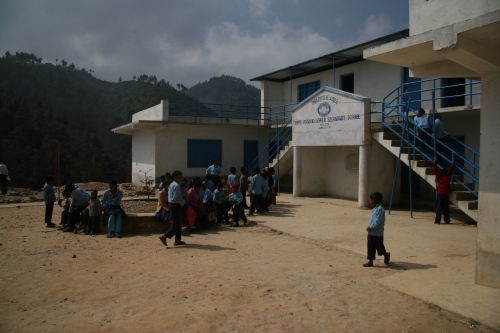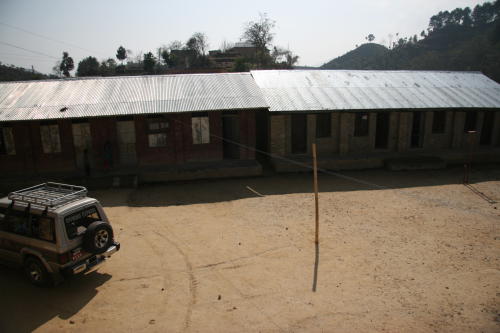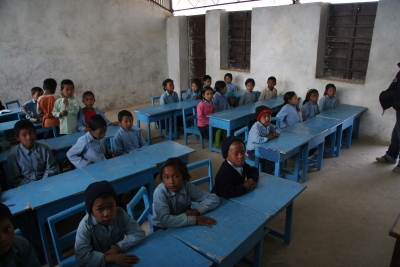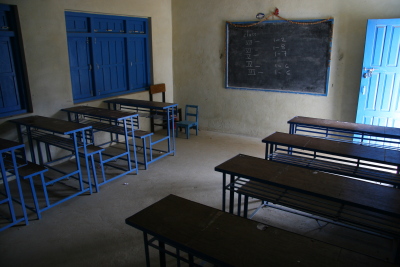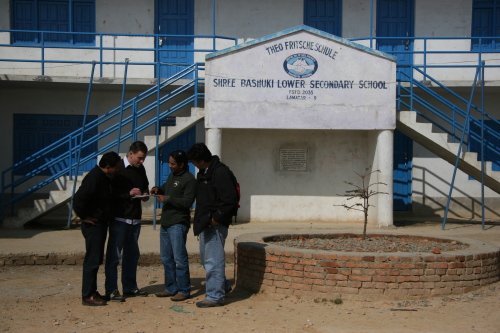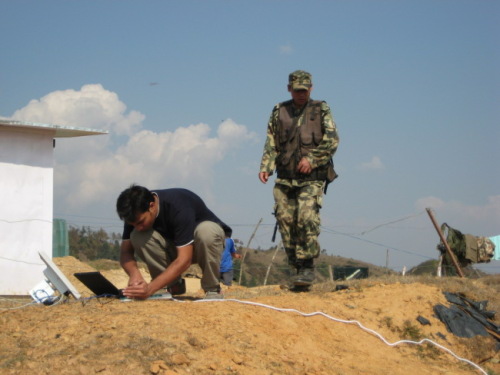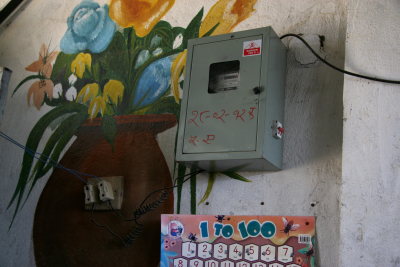Bashuki Journal: Difference between revisions
mNo edit summary |
m (Reverted edits by No no no no no no no no NO (Talk) to last revision by Nhorning) |
||
| (24 intermediate revisions by 11 users not shown) | |||
| Line 1: | Line 1: | ||
<center><div style="background-color:#c1fea1; border:1px solid #cdf; padding:0px; align:center;font-size:120%" class="plainlinks"> |
|||
'''← [[Bishwamitra_Journal|Last]]''' · |
|||
'''[[OLE_Nepal#Nepal_Pilot_Sites|Home]]''' · |
|||
'''[[Nepal:_Teacher_Preparation|Next]] →''' |
|||
</div> |
|||
</center> |
|||
<noinclude>{{ GoogleTrans-en | es =show | bg =show | zh-CN =show | zh-TW =show | hr =show | cs =show | da =show | nl =show | fi =show | fr =show | de =show | el =show | hi =show | it =show | ja =show | ko =show | no =show | pl =show | pt =show | ro =show | ru =show | sv =show }}</noinclude> |
|||
| ⚫ | |||
'''Shree Bashuki Lower Secondary School''' |
'''Shree Bashuki Lower Secondary School''' |
||
I will note down the details of this pilot school as they happen. [[User:Berrybw|Bryan Berry]] 08:42, 7 March 2008 (EST) |
I will note down the details of this pilot school as they happen. [[User:Berrybw|Bryan Berry]] 08:42, 7 March 2008 (EST) |
||
For comprehensive information about the Nepal's deployments, including planning, technical, and pedagogical preparations, see the [[OLPC_Nepal#Implementation|Implementation]] section of the OLPC Nepal wiki page. |
|||
For the most up-to-date details, see the [http://blog.olenepal.org OLE Nepal blog]. |
|||
You can read about Nepal's other pilot school at [[Bishwamitra Journal]] |
You can read about Nepal's other pilot school at [[Bishwamitra Journal]] |
||
| Line 24: | Line 36: | ||
Bashuki school has grades 1-8 and roughly 320 total students. It is located roughly 30 km east of Kathmandu at the top of a very steep ridge. Most of the teachers walk over an hour to reach the school. It is a poor school and most of children belong to the [http://en.wikipedia.org/wiki/Tamang Tamang] indigenous group, one of the historically disadvantaged groups in Nepal. We will pilot OLPC in grades 2 and 6 at this school. There are 37-40 kids in both classes 2 and 6. |
Bashuki school has grades 1-8 and roughly 320 total students. It is located roughly 30 km east of Kathmandu at the top of a very steep ridge. Most of the teachers walk over an hour to reach the school. It is a poor school and most of children belong to the [http://en.wikipedia.org/wiki/Tamang Tamang] indigenous group, one of the historically disadvantaged groups in Nepal. We will pilot OLPC in grades 2 and 6 at this school. There are 37-40 kids in both classes 2 and 6. |
||
Teachers from Bashuki and Bishwamitra schools attended OLE Nepal's [http://blog.olenepal.org/index.php/archives/119 Teacher Interaction Program] held in cooperation with Nepal's National Center for Educational Development, Nepal's national teacher training organization. |
|||
[[Image:Teacher-interaction-Program.jpg|225px]] |
|||
Here is the room for Class 2. We were happy to see that the desks are relatively close to the ground so there is less distance for the XO’s to fall. We plan to reorient the desks so the desks so that the kids face each other. We think this will facilitate collaboration and make it less likely for XO’s to fall off the desks. Each desk is roughly 1.5 m X 1.5 m. Saurav told me that these desks are significantly wider than desks at many schools. Kids would have difficulty typing at smaller desks. We expect there to be roughly 37 kids in Class 2 at Bashuki at the start of the school year. The room is roughly 6 meters by 5 meters. |
Here is the room for Class 2. We were happy to see that the desks are relatively close to the ground so there is less distance for the XO’s to fall. We plan to reorient the desks so the desks so that the kids face each other. We think this will facilitate collaboration and make it less likely for XO’s to fall off the desks. Each desk is roughly 1.5 m X 1.5 m. Saurav told me that these desks are significantly wider than desks at many schools. Kids would have difficulty typing at smaller desks. We expect there to be roughly 37 kids in Class 2 at Bashuki at the start of the school year. The room is roughly 6 meters by 5 meters. |
||
| Line 36: | Line 44: | ||
[[Image:Bashuki_Class_6_small.JPG]] |
[[Image:Bashuki_Class_6_small.JPG]] |
||
== Implementation Team == |
|||
[http://www.olenepal.org Open Learning Exchange Nepal] is the lead implementer for the pilot, cooperating with Nepal's Department of Education. The Danish IT Society has purchased the XO's for the pilot and the Embassy of Denmark in Nepal is covering the other costs. |
|||
From the Department of Education: |
|||
* Baburam Poudel - Deputy Director at the Department of Education, oversees the OLPC project in Nepal |
|||
* Kamal Kafle - Goverment's technical adviser to the project |
|||
* Arjun Aryal - government technical advisor |
|||
From [http://www.olenepal.org OLE Nepal] |
|||
* Rabi Karmacharya, Executive Director |
|||
* Dr. Saurav Dev Bhatta, Education Director |
|||
* Mahabir Pun, Networking and Infrastructure |
|||
* Sulochan Acharya, all technical matters at the school, esp. XO's and School Server |
|||
* Dev Mohanty, Network Engineer for wireless links |
|||
* Ram Krishna Singh, power technician |
|||
* Bryan Berry, systems engineer, School Server, XO configuration, E-Library |
|||
There is also a activity development team at OLE Nepal that is working exclusively on creating constructionist learning activities for the pilot. They are less involved in the on-site implementation details. |
|||
From Bashuki School: |
|||
* Shiva Hari Dahal, principal |
|||
* Raju Ghimire, vice principal |
|||
The combined implementation team has been working together for over 4 months preparing for this pilot. It has been our experience so far that an OLPC pilot requires a significant amount of human resources. It would not be possible to implement a pilot in Nepal without full-time staff. We do not think it could be accomplished w/ a team of part-time volunteers. The OLE Nepal team includes volunteers, but the core team works on the project full-time. |
|||
I have discussed the matter of full-time staff with Amit Gogna, the lead implementer for India's first pilot at Khairat. He agrees that an OLPC implementation, even for a single school, requires full-time staff. His team has a total of 7 persons. One of the goals for our implementation team is to streamline the implemenation process for OLPC so it can be implemented with a minimum of human resources and use local resources wherever possible. |
|||
= Planning = |
= Planning = |
||
| Line 73: | Line 52: | ||
== Network == |
== Network == |
||
[Technical Details and Update by Dev Mohanty] |
|||
We will put the point to point radio at either the army base on the right or mounted on one of the trees the far left. The trees and the army base have direct line-of-sight with the Department of Education, in a range of 3-4 km air distance. |
We will put the point to point radio at either the army base on the right or mounted on one of the trees the far left. The trees and the army base have direct line-of-sight with the Department of Education, in a range of 3-4 km air distance. |
||
| Line 85: | Line 66: | ||
We are using Deliberant brand of radios for the point-to-point connection to the Department of Education. The radio has an effective bandwidth 8 Mbps. Since the radio will be transmitting at a distance of 4 km to the Department of Education located in the Kathmandu Valley, interference will be an issue. |
We are using Deliberant brand of radios for the point-to-point connection to the Department of Education. The radio has an effective bandwidth 8 Mbps. Since the radio will be transmitting at a distance of 4 km to the Department of Education located in the Kathmandu Valley, interference will be an issue. |
||
We do not intend to use VSAT for any of Nepal's pilot schools. Installation is not terribly expensive but monthly bandwidth charges are prohibitively expensive when compared with the cost of long-range wifi networks, as pioneered by [http://www.nepalwireless.net Nepal Wireless] |
We do not intend to use VSAT for any of Nepal's pilot schools. Installation is not terribly expensive but monthly bandwidth charges are prohibitively expensive when compared with the cost of long-range wifi networks, as pioneered by [http://www.nepalwireless.net Nepal Wireless Project] |
||
[15th March 08 Update] |
|||
We got an 16dbi Deliberant installed at DOE. Being a hazy day, the hills where the schools were located were pretty much next to not being visible. So getting the angles right was all the more challenging, as this relay needs to be broadcasting to both schools simultaneously. And unlike a Canopy a Deliberant radio can broadcast to different relays within an angle of 60-70 degrees. So let's hope we've got it right, which we'd know once at Bashuki. |
|||
[25th March 08 Update] |
|||
We were back to the school to complete this end of the networking. Which required us to fix a relay from DOE at the Army outpost and get it connected to the school and also setup an omni antenna as an AP for the XOs. After half an hour of diplomatic talks with the Army officer in-charge of the barrack, we were finally allowed to setup it up. Since we could not use power from the barrack. We decided to run a cat5 cable across to the school about 100 mtrs away to power up the radio over POE from the switch at the school. For certain reasons the 16di radio refused to power up, and we had to use the 19dbi radio instead as the relay which gave connectivity at 72 dbm rssi 0% packet loss. That was the highlight of the day, as the omni radio too refused to power up, so we didn't get to install it. |
|||
[[Image:Army_camp.JPG]] |
|||
Prior to leaving we did install a battery and an UPS with the XS connected to the switch, though it all needs to be thoroughly tested. Maybe in a couple of days, when I get there next to install the omni radio. |
|||
Shown below is the Planned Network Design |
Shown below is the Planned Network Design |
||
| Line 123: | Line 116: | ||
== Teacher Training == |
== Teacher Training == |
||
For full details see [[Nepal: Teacher Training]] |
|||
Teachers will receive four days of training off-site 1-2 weeks prior to the pilot. Each teacher will receive their own laptop. More details to come . . . |
|||
| ⚫ | |||
We held a [http://blog.olenepal.org/index.php/archives/119 Teacher Interaction Program] on January 14th that shaped many aspects of our teacher training plan. |
|||
== Content Development and Content Acquisition == |
|||
[[category:Nepal]] |
|||
OLE Nepal is developing [http://dev.laptop.org/pub/epaati/Epaati-8.xo E-Paati] suite of learning activities for the pilot. These activities were developed in EToys and are under the MIT license. So far the E-Paati suite contains mathematics and English activities for grades two and six. We feel that developing local content is extremely important for the success of this pilot. Child-centered, constructionist learning is a foreign concept for most Nepali schools. Our plan is to gently introduce constructivist, interactive learning activities that are based on the current Nepali learning materials. This way, the new materials will be less alien and the mode of instruction more readily adopted. We don't want to force a completely new mode of teaching and learning onto the teachers from day one. |
|||
[[Category:OLPC Nepal]] |
|||
[[Category:Field Reports]] |
|||
For full details see the following: |
|||
Content Acquisition is a time-consuming process. Several groups that create storybooks and children's literature have already contributed digital versions of their materials for the pilot. These materials will be licensed under the Creative Commons 3.0 Attribution-NonCommercial-NoDerivatives license. We strongly prefer to not have the No Derivatives clause but we have found it difficult to convince publishers to allow derivatives. |
|||
[http://blog.olenepal.org/index.php/archives/321 Formative Evaluation of OLPC Project Nepal: A Summary] |
|||
[http://blog.olenepal.org/index.php/archives/325 Notes from Nepal’s OLPC Deployments] |
|||
== School Selection Process == |
|||
The Department of Education selected Bashuki school based on the following criteria: |
|||
| ⚫ | |||
* Majority of students come from disadvantaged castes |
|||
* Relatively remote location but accessible from Kathmandu |
|||
* School already has electricity |
|||
== Why Grades 2 and 6? Why mathematics and English? == |
|||
We chose Class 2 over Class 1? Because a large portion of Nepali schoolchildren do not attend preschool. In grade one they are just getting used to being in school. With Class 2, they are already accustomed to attending school but young enough that we can measure how well this initiative helps young children. |
|||
We chose class 6 because a large portion of Nepali children drop at class 6. Also, we can test out more complicated learning activities and this challenges us to see how well our strategies work with higher subjects. In 2009, we plan to expand to classes 3 and 7, 2010 to 4 and 8, until we cover all public school grades. |
|||
Nepali students perform very poorly in mathematics and English on standardized exams. These are also the most valued skills. We think we can make the most positive impacts here. |
|||
== Maintenance Plan == |
|||
We will show the teachers how to perform basic maintenance and give periodic short courses to the students on laptop maintenance. Rather create a fully structured maintenance plan, we want to see who at the school shows the most affinity for laptop maintenance, students or teachers. We don't want to arbitrarily select local people to do the maintenance until we get a sense of who has an interest and talent for it. In short, we are putting People before Process. |
|||
== Evaluation == |
|||
| ⚫ | |||
Latest revision as of 17:35, 26 February 2011
Translate this page with Google -español -български -中文(中国大陆) -中文(臺灣) -hrvatski -čeština -dansk -Nederlands -suomi -français -Deutsch -Ελληνικά -हिन्दी -italiano -日本語 -한국어 -norsk -polski -português -română -русский -svenska
Ulaanbaatar.mn | Arahuay.pe | Khairat.in | Ban Samkha.th | Galadima.ng | Cardal and CEIBAL.uy | Bashuki.np | Bishwamitra.np | Atlas School.pk | Altos de Cazucá.co [+/-]
Shree Bashuki Lower Secondary School
I will note down the details of this pilot school as they happen. Bryan Berry 08:42, 7 March 2008 (EST)
For comprehensive information about the Nepal's deployments, including planning, technical, and pedagogical preparations, see the Implementation section of the OLPC Nepal wiki page.
For the most up-to-date details, see the OLE Nepal blog.
You can read about Nepal's other pilot school at Bishwamitra Journal
Background
The pilot will begin on the first day of the Nepali school year, April 14th.
The new white school building was built with financial assistance from a German charity. Below is a picture of the old school buildings, still used for grades 1-3 and a nursery.
Community
Bashuki School is located in the village of Lakuri Bhanjyang, situated high upon a hill ridge roughly 1 hours walk from the main road. There is a coarse gravel road leading to the school that is only accessible by motorcycle or a 4-wheel drive vehicle. Here is a view from the school roof down at the Kathmandu Valley.
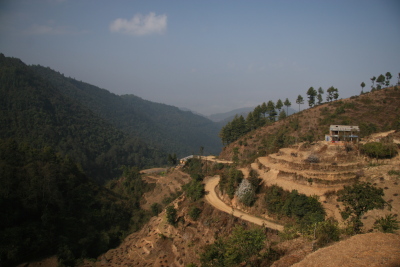
The School
Bashuki school has grades 1-8 and roughly 320 total students. It is located roughly 30 km east of Kathmandu at the top of a very steep ridge. Most of the teachers walk over an hour to reach the school. It is a poor school and most of children belong to the Tamang indigenous group, one of the historically disadvantaged groups in Nepal. We will pilot OLPC in grades 2 and 6 at this school. There are 37-40 kids in both classes 2 and 6.
Here is the room for Class 2. We were happy to see that the desks are relatively close to the ground so there is less distance for the XO’s to fall. We plan to reorient the desks so the desks so that the kids face each other. We think this will facilitate collaboration and make it less likely for XO’s to fall off the desks. Each desk is roughly 1.5 m X 1.5 m. Saurav told me that these desks are significantly wider than desks at many schools. Kids would have difficulty typing at smaller desks. We expect there to be roughly 37 kids in Class 2 at Bashuki at the start of the school year. The room is roughly 6 meters by 5 meters.
Here is the room for Class VI. About 37 kids will fit into the room, roughly 4 kids per bench. This room is physically smaller than the Class II room. The classroom measures roughly 3.5 meters by 5 meters. The surface area of the bench is quite narrow and only just wide enough to accommodate the XO. We were concerned that the XO’s would easily fall off the benches. It is very important that we rearrange the benches so the kids are facing each other and it will be less likely for the XO’s to fall forward onto the ground. We will put the charging rack to the left of the blackboard as it is the only space available for it in the room.
Planning
Left to Right: Saurav Dev Bhatta, Bryan Berry, Rabi Karmacharya, and Ram Krishna Singh
Network
[Technical Details and Update by Dev Mohanty]
We will put the point to point radio at either the army base on the right or mounted on one of the trees the far left. The trees and the army base have direct line-of-sight with the Department of Education, in a range of 3-4 km air distance.
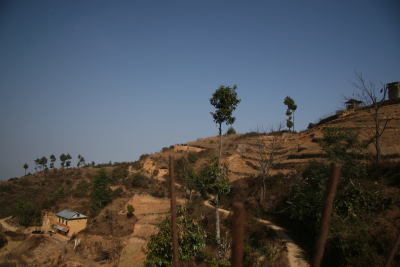
Mahabir Pun is in charge of all network and infrastructure planning and Dev Mohanty is the network engineer.
We are using Point-to-Point 802.11g radios to provide Internet access to the school. We will put the Point-to-Point radio for Bashuki School either at the adjacent Military Post or on a tree situated on a high hilltop. The radio located near Bashuki will connect to a multi-point radio located at the Department of Education, 8 km (by road) east of the school and in direct line of sight.
We may use a 12 dbi omni-directional antenna from Deliberant Networks, onsite at the school. We will likely not use the Active Antenna, at least initially. We are using a Deliberant DLB-2701 as the access point. It costs roughly 100 euro and has a range of 12 km in ideal conditions. It operates in the 802.11 b/g wifi range.
We are using Deliberant brand of radios for the point-to-point connection to the Department of Education. The radio has an effective bandwidth 8 Mbps. Since the radio will be transmitting at a distance of 4 km to the Department of Education located in the Kathmandu Valley, interference will be an issue.
We do not intend to use VSAT for any of Nepal's pilot schools. Installation is not terribly expensive but monthly bandwidth charges are prohibitively expensive when compared with the cost of long-range wifi networks, as pioneered by Nepal Wireless Project
[15th March 08 Update]
We got an 16dbi Deliberant installed at DOE. Being a hazy day, the hills where the schools were located were pretty much next to not being visible. So getting the angles right was all the more challenging, as this relay needs to be broadcasting to both schools simultaneously. And unlike a Canopy a Deliberant radio can broadcast to different relays within an angle of 60-70 degrees. So let's hope we've got it right, which we'd know once at Bashuki.
[25th March 08 Update]
We were back to the school to complete this end of the networking. Which required us to fix a relay from DOE at the Army outpost and get it connected to the school and also setup an omni antenna as an AP for the XOs. After half an hour of diplomatic talks with the Army officer in-charge of the barrack, we were finally allowed to setup it up. Since we could not use power from the barrack. We decided to run a cat5 cable across to the school about 100 mtrs away to power up the radio over POE from the switch at the school. For certain reasons the 16di radio refused to power up, and we had to use the 19dbi radio instead as the relay which gave connectivity at 72 dbm rssi 0% packet loss. That was the highlight of the day, as the omni radio too refused to power up, so we didn't get to install it.
Prior to leaving we did install a battery and an UPS with the XS connected to the switch, though it all needs to be thoroughly tested. Maybe in a couple of days, when I get there next to install the omni radio.
Shown below is the Planned Network Design
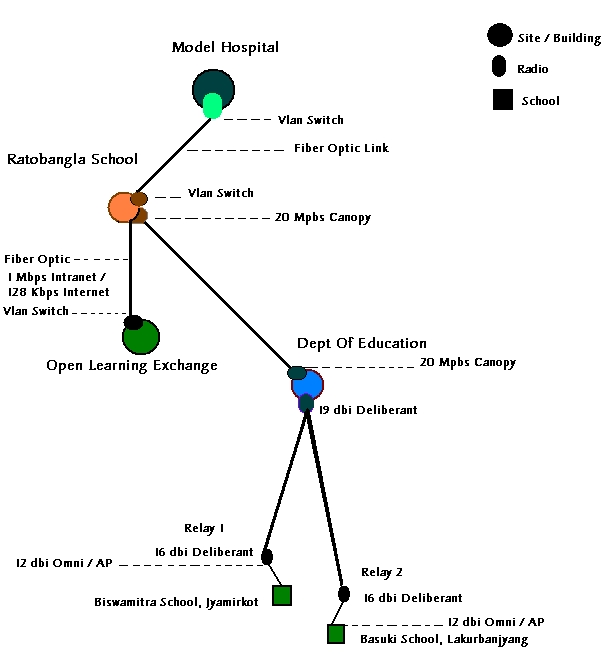
Power
Ram Krishna Singh is the lead power technician for the pilot.
Stable electricity is a significant problem everywhere in Nepal. Currently the school only receives 16 hours of electricity per day. This should decrease to 15 or 14 hours per day by April. Hydropower generates most of the electricity for Nepal's energy grid and the amount generated decreases steadily during the dry season, October - May.
There are only 5 amps of power coming into the school. Josh says that we need at least 7.5 amps to charge 110 laptops. Ram estimates we need 10 - 15 amps because of power loss and distribution inefficiencies.
Power is also of low quality, with frequent brownouts and power spikes. The power strips available in Nepal are of very low quality, there is high chance that children will shock themselves while removing their plug from the power strips. It is not uncommon to see a spark when you insert a plug into the particular power strip available in Nepal.
We will install a “charging rack” at the back of each classroom. The children will unplug the XO’s and use them at their desks untethered by power cables. There will be a space and charger for each child’s XO in the rack. We do not plan to run power cables to the desks. The chance that kids will trip over power cables is just too high.
We would love to use the Xoctoplug for power distribution should it become available. It is much more elegant and safe manner of distributing power than regular power strips. We would place the Xoctoplug in the middle of 4 desks and the kids would plug into the Xoctoplug. Since the Xoctoplug distributes DC current it is much more efficient and safer than an AC power strip. Additionally we could daisy-chain two Xoctoplugs together so that we would only have live power cable per 8 kids, as opposed to one live power cable for every 3 kids which we would need for power strips.
We will install power inverters in the school to maintain power during power outages. We will keep the inverters in the same location as the School Server.
School Server
Sulochan Acharya and Bryan Berry are in charge of the School Server, XO maintenance, and E-Library.
The school server will use OLPC's school server distribution with some modifications. The School Servers will not connect directly to the Internet but through a server located at the Department of education. This server will host the Dansguardian content filter and Squid proxy. The School Server will only host the Jabber Server, DNS, DHCP, and a few other services. We are using off-the-shelf hardware for the school server.
We will keep the school server and power inverters.
Physical Security
The school does not have a fence around it. There appears to be a caretaker that lives at the school. The rooms in the new building seem fairly secure and the rooms in the old building less so. There are locks for all the classrooms.
We expect the children to take their XO's home with them but the School Server, power backup equipment, and charging racks will need to be secured. Power backup equipment is particularly valuable in Nepal due to supply shortages.
Teacher Training
For full details see Nepal: Teacher Training
Experiences
For full details see the following:
